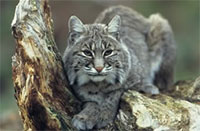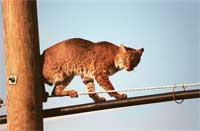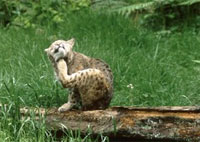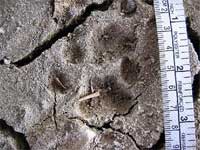|

 They have reddish-brown or yellowish-brown coats that are streaked with black or dark brown and have prominent, pointed ears with a tuft of black hair at the tip. Although uncommon, some individuals have been found spotted with rosettes similar to an ocelot. They have white underparts. They are named for their short or "bobbed" tail. Bobcats stand approximately 45–58 cm (19–22 inches) high at the withers. The male Bobcat typically weighs from 11–16 kg (24–35 lb). They have reddish-brown or yellowish-brown coats that are streaked with black or dark brown and have prominent, pointed ears with a tuft of black hair at the tip. Although uncommon, some individuals have been found spotted with rosettes similar to an ocelot. They have white underparts. They are named for their short or "bobbed" tail. Bobcats stand approximately 45–58 cm (19–22 inches) high at the withers. The male Bobcat typically weighs from 11–16 kg (24–35 lb).

 City cats: Its habitat is deciduous forests, semi-deserts, scrublands and wooded areas in most of the United States and Mexico. They can also survive in cities. The Bobcat can be found in a few parts of southern Canada, where its range overlaps with the habitat of the related Canada lynx. Hybridization between wild Canada lynx and Bobcat has been documented in Maine and Minnesota. City cats: Its habitat is deciduous forests, semi-deserts, scrublands and wooded areas in most of the United States and Mexico. They can also survive in cities. The Bobcat can be found in a few parts of southern Canada, where its range overlaps with the habitat of the related Canada lynx. Hybridization between wild Canada lynx and Bobcat has been documented in Maine and Minnesota.
 Ever adapting cats: Unlike the larger Canada lynx, which they resemble, Bobcats are often highly adaptable to human-caused changes in environmental conditions; some biologists believe that there are more bobcats in the United States today than in colonial times. They have vanished from parts of the midwest where most suitable habitat has been replaced by cultivated fields. Ever adapting cats: Unlike the larger Canada lynx, which they resemble, Bobcats are often highly adaptable to human-caused changes in environmental conditions; some biologists believe that there are more bobcats in the United States today than in colonial times. They have vanished from parts of the midwest where most suitable habitat has been replaced by cultivated fields.
Hunting: Bobcats are carnivores that typically hunt wild rabbits, hares, and rodents, but will also attempt to hunt the larger deer in winter months when other food is scarce.

They breed in late winter or early spring and have a gestation period of about two months. A female may have one to six kittens each year. Although adapted to a variety of habitats across the country, they do not tolerate the deep snows. Bobcats move about their home ranges most actively in the hours near dawn and dusk, hunting small mammals. They seek cover in conifer stands and on rocky ledges.

 Paw prints: Bobcat tracks show four toes, generally without claw marks. Individual adult tracks are generally 5 cm (2 in) in size with about 25 cm between tracks in the direction of travel. Like all cats, bobcats directly register, meaning their hind prints usually fall exactly on top of their fore prints. Bobcat tracks can generally be distinguished from feral or house cat tracks by their size (feral cat tracks being about 3.8 cm (1.5 inches) square) and also by the indentation at the top of the bobcat's foot pad (feral cat tracks generally show a single, rounded hump at the top of the foot pad). Paw prints: Bobcat tracks show four toes, generally without claw marks. Individual adult tracks are generally 5 cm (2 in) in size with about 25 cm between tracks in the direction of travel. Like all cats, bobcats directly register, meaning their hind prints usually fall exactly on top of their fore prints. Bobcat tracks can generally be distinguished from feral or house cat tracks by their size (feral cat tracks being about 3.8 cm (1.5 inches) square) and also by the indentation at the top of the bobcat's foot pad (feral cat tracks generally show a single, rounded hump at the top of the foot pad).
All text is available under the terms
of the GNU Free Documentation License
|